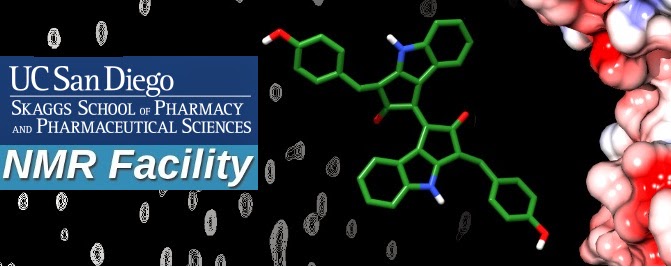One of the many recent innovations to make acquiring NMR data faster is the NOAH technique. NOAH concatenates several pulse sequences behind a single relaxation delay to reduce the total acquisition time. Various combinations of experiments are available, but perhaps the most useful is the NOAH_BSC variant which provides a gCOSY, 13C HSQC and 13C HMBC. In this post the NOAH_BSC spectra are compared with those collected using the standard Facility parameters.
Wednesday, December 1, 2021
Tuesday, November 2, 2021
Temperature and multiple conformations
Molecules that can adopt multiple conformations may show multiple peaks in NMR spectra. One way to test if the extra peaks in your spectrum are due to conformational isomers is to change the temperature. Changing the temperature will change the rate of exchange between the conformations and alter the chemical shifts. In addition to confirming the cause of the extra peaks variable temperature NMR may also provide thermodynamic information. An example based on the thyroid hormone thyroxine is described below.
Monday, October 4, 2021
The sign of NOESY peaks
Occasionally NOESY spectra of small molecules show a mixture of positive and negative peaks. The negative peaks are often due to exchange between different magnetic environments. I recently came across a good example of this in the NOESY spectrum of 2,3-dihydroxybenzamide.
Thursday, September 2, 2021
HETCOR
The HETCOR (HETeronuclear CORrelation) experiment produces a two dimensional spectrum that correlates protons and a heteronucleus, typically carbon. It is one of the earliest 2D experiments and is best used with a direct detect probe. Today, the HETCOR experiment has been replaced by the HSQC experiment. This post will discuss why the HETCOR experiment is now little used and under what circumstances you might still want to use it.
Wednesday, August 4, 2021
PANSY: Parallel Acquisition NMR Spectroscopy
Parallel Acquisition NMR Spectroscopy (PANSY) is an innovation that increases the amount of NMR data that can be collected in a given amount of time. PANSY experiments are possible with new spectrometer hardware that includes multiple receivers.
Friday, July 2, 2021
NORD: No Relaxation Delay NMR spectroscopy
No Relaxation Delay (NORD) NMR spectroscopy is a method for making the acquisition of NMR spectra less time consuming. By modification of the pulse sequences and careful ordering of the experiments it is possible to eliminate the most time consuming part, the relaxation delay.
Wednesday, June 2, 2021
NOAH supersequences
Much of the time taken to acquire multi-dimensional NMR spectra is consumed by the relaxation delay. NOAH (NMR by Ordered Acquisition using 1H-detection) is a method developed to interleave several experiments and use a single relaxation delay for the whole group, thereby reducing the time taken to acquire a series of experiments.
Tuesday, May 4, 2021
Flattening 1D 13C spectra
The 1D 13C spectra collected in the SSPPS NMR Facility often show uneven baselines. The usual baseline correction routines do not improve the spectra much, but recently I discovered that Bruker provides a processing macro that can dramatically improve the appearance of these spectra.
Friday, April 9, 2021
Investigating "Boosted Mobility" in DOSY experiments
Late last year Prof Mike Gilson sent me a Science paper that reported "boosted mobility" of molecules during reactions. The conclusions were based in part on DOSY experiments and since the reported increases were greater than expected, Prof Gilson was interested in a second opinion on the NMR experiments. As I started looking at the data a technical comment disputing the results, and a response from the original authors was published. The original group then published another paper addressing the problems raised by the second group and made their raw NMR data freely available. A few weeks ago the second group published a preprint where they argue the first group's data was not analysed correctly and the conclusions are invalid. In this post I'll go through the data from both groups, my own analysis of the data, and try to make some sense of it all.
Tuesday, March 2, 2021
Determining concentration from NMR spectra
One of the strengths of NMR is that the signal is directly proportional to the amount of material present. This makes it possible to measure concentrations without having a sample of the pure material. This post describes how to use the residual protonated solvent signal as an internal standard to determine concentration.
Friday, February 5, 2021
Constant time
Collecting multi-dimensional spectra requires recording chemical shift information via the use of an incremented delay. Since the length of the delay increases over the course of the experiment the signal is recorded at different times for each increment. This allows coupling in the indirect dimension to evolve, which broadens the peaks and decreases resolution. The "constant time" method was developed to eliminate this problem.
Thursday, January 7, 2021
Two-dimensional NMR
The development of two dimensional NMR in the 1970s was probably the greatest advance in the history of the technique. The addition of another dimension to NMR spectra expanded the types of information obtainable and made possible the vast array of tailored multi-dimensional experiments available today. The development of two dimensional experiments relied upon the introduction of pulsed NMR and the use of the fourier transform to process the data. To generate two dimensional data a variable delay between two pulses must be used. Incrementing the variable delay allows chemical shift information to be regularly sampled and later processed with the fourier transform to give a second dimension. Read on for more details.
